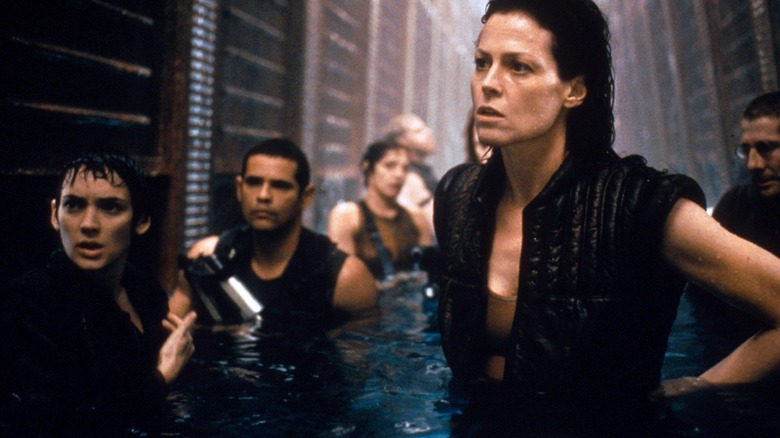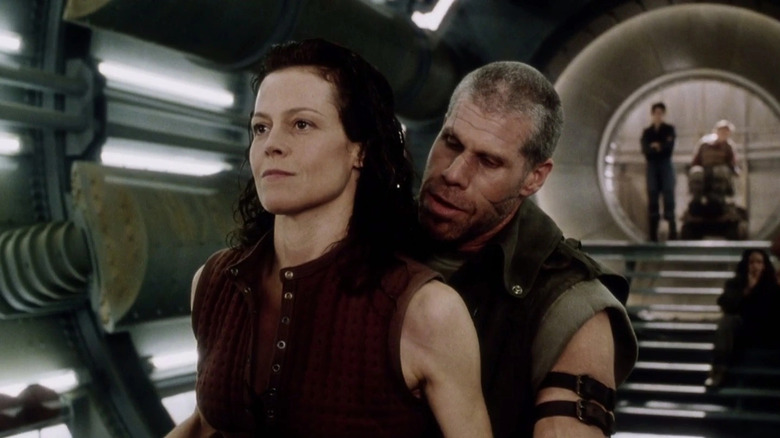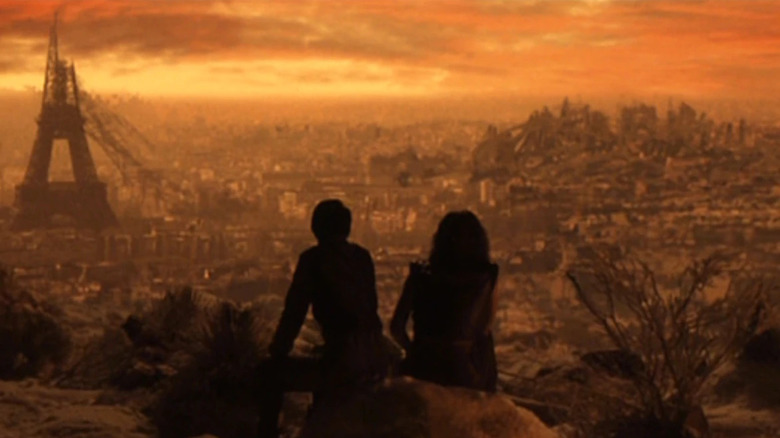Out Of Every Alien Resurrection Ending, Joss Whedon Thinks They Picked The Worst
That fourth film in a franchise is always a tricky one, and for every "Mad Max: Fury Road," there are many more like "Indiana Jones and The Kingdom of the Crystal Skull," a movie that not only stinks in its own right but manages to diminish a well-loved series by merely existing.
"Alien Resurrection" fell somewhere towards the latter, although the damage was softened by following David Fincher's much-maligned "Alien 3." It's a weird movie, but if you're going to resurrect your main character to keep your franchise going beyond its logical end point ("Alien 3" was a bummer, but Ripley's arc made sense), then making her an human-alien hybrid is at least an interesting way to go.
Despite the extremely muted response to "Alien 3," 20th Century Fox pushed ahead with plans for a fourth entry, envisaging a story focusing on a cloned version of Newt, the young girl Ripley battled so ferociously to save in "Aliens" but killed off so callously at the beginning of the third film. To this end, they hired Joss Whedon to write the screenplay. As Whedon told In Focus magazine (via Go Into The Story):
"Because I'd done some action movies and I'd done 'Buffy,' they said, 'Well, he can write teenage girls, and he can write action, so let's give him a shot.'"
Fox soon changed their minds and chose to bring back Ripley, as she was the backbone of the franchise. Whedon complied, and the studio was pleased with the results. There was just a little problem with the ending.
So what happens in Alien Resurrection again?
Two centuries after Ellen Ripley (Sigourney Weaver) took a dive into a pool of molten metal, taking her newborn Alien Queen with her, those dastardly military types have figured out a way of cloning her and her parasitic offspring. It's all very shady, carrying out their experiments on the USM Auriga outside regulated space. A band of space pirates arrive with a cargo of illicit human subjects for impregnation by a fresh batch of eggs, overseen by the transparently villainous Dr. Wren (J.E. Freeman) and his weirdo colleague Dr. Gediman (Brad Dourif).
It doesn't take long for a new squad of Xenomorph warriors to bust loose and decimate the Auriga's crew, leaving Ripley (enhanced by Xenomorph DNA) to help the pirates battle their way to their ship and escape. Naturally, the Alien Queen's gloopy human-alien newborn hitches a ride.
Jean-Pierre Jeunet was a brave choice as director, but his penchant for grotesque humor often distracts from the suspense. Still, he has a unique vision and gives the franchise's usual dark steel corridors a new perspective, and he stages one outstanding underwater set piece. The practical effects are vivid, with the eggs, facehuggers, warriors, and the queen getting an extra-lifelike revamp, although the CG aliens have dated badly. The performances are a mixed bag, with Weaver clearly having fun with Ripley's new sinister side. The rest of the cast don't fare so well, veering from hopelessly miscast (a whiny Winona Ryder) to pantomime (just about everyone else). Then we have the movie-breaking newborn...
The worst of all possible endings?
Joss Whedon's original screenplay for "Alien Resurrection" finally took the franchise to the place Ripley spent three films trying to prevent the Xenomorphs reaching: Earth. In his first draft, Ripley battles the newborn in a forest before it can reach civilization. Whedon, an outspoken critic of the final film, told In Focus (via Go Into the Story):
"I just kept saying, 'The reason people are here is we're going to do the thing we've never done; we're gonna go to Earth.' But there were a lot of things that we hadn't done that we ended up not doing because of a singular lack of vision."
Whedon's first conclusion was rejected, so he wrote three more in a junkyard, a maternity ward, and a desert. Eventually, the prospect of an Earth-bound showdown was cut due to financial concerns, resulting in the existing denouement where the newborn is sucked out of a spaceship via a small hole in the hull.
Whedon also took issue with the design of the creature itself, which he wrote as a white bloodsucking spider-like monster with pincers:
"I just gave them dialogue and stuff, but I don't remember writing, 'A withered, granny-lookin', Pumpkinhead-kinda-thing makes out with Ripley...' Pretty sure that stage direction never existed in any of my drafts."
A final scene set on Earth was shot with a post-apocalyptic Paris, but thankfully it was cut because it had a chance to give us strong groan-inducing "Planet of the Apes" vibes.
"Alien Resurrection" looks better nowadays, especially after all that "Alien vs Predator" malarkey. Plus, Ridley Scott's "Prometheus" and "Alien: Covenant" prequels stripped the creatures of their mystery and terror. If anything, the sequel is a fascinating failure, and I'm not convinced that Whedon's original vision would have worked in Jeunet's hands anyway. As relentless as the Xenomorphs are, Earth may have been one step too far for the deadly creatures.


